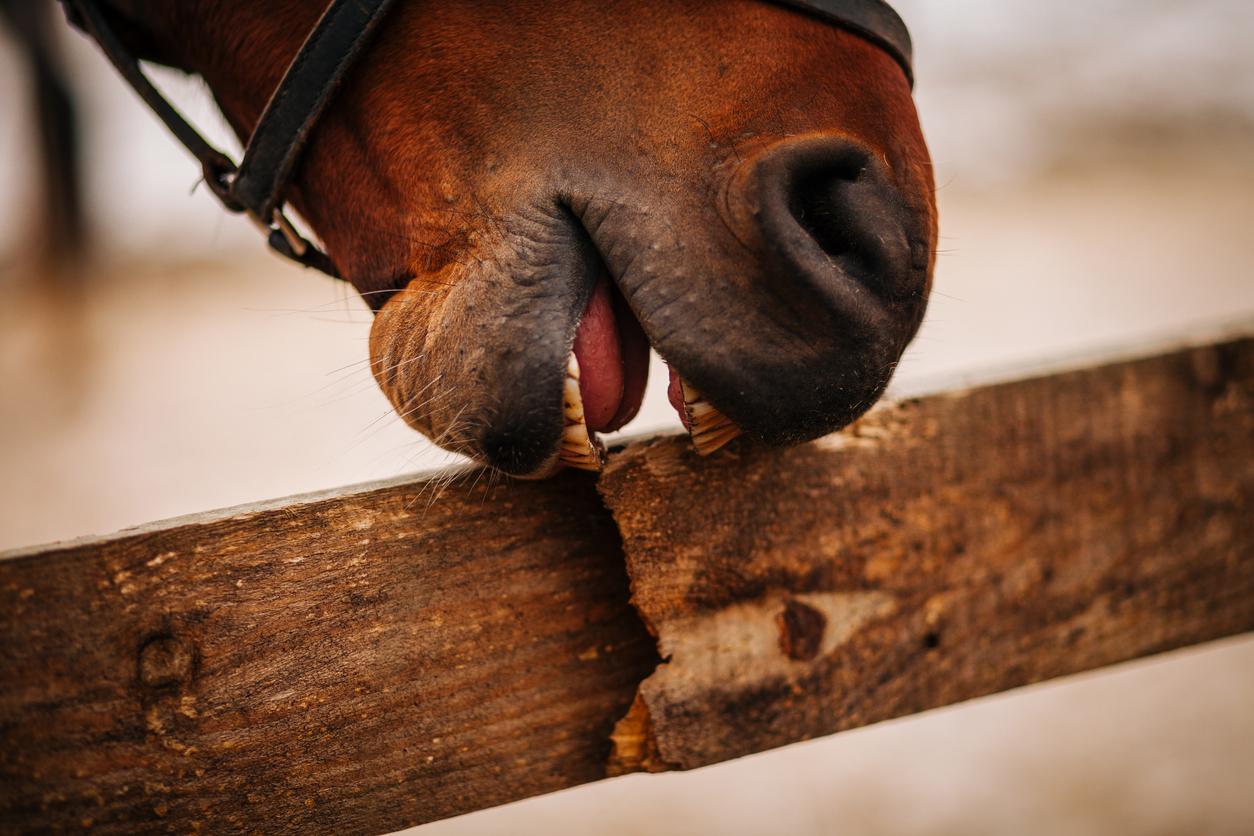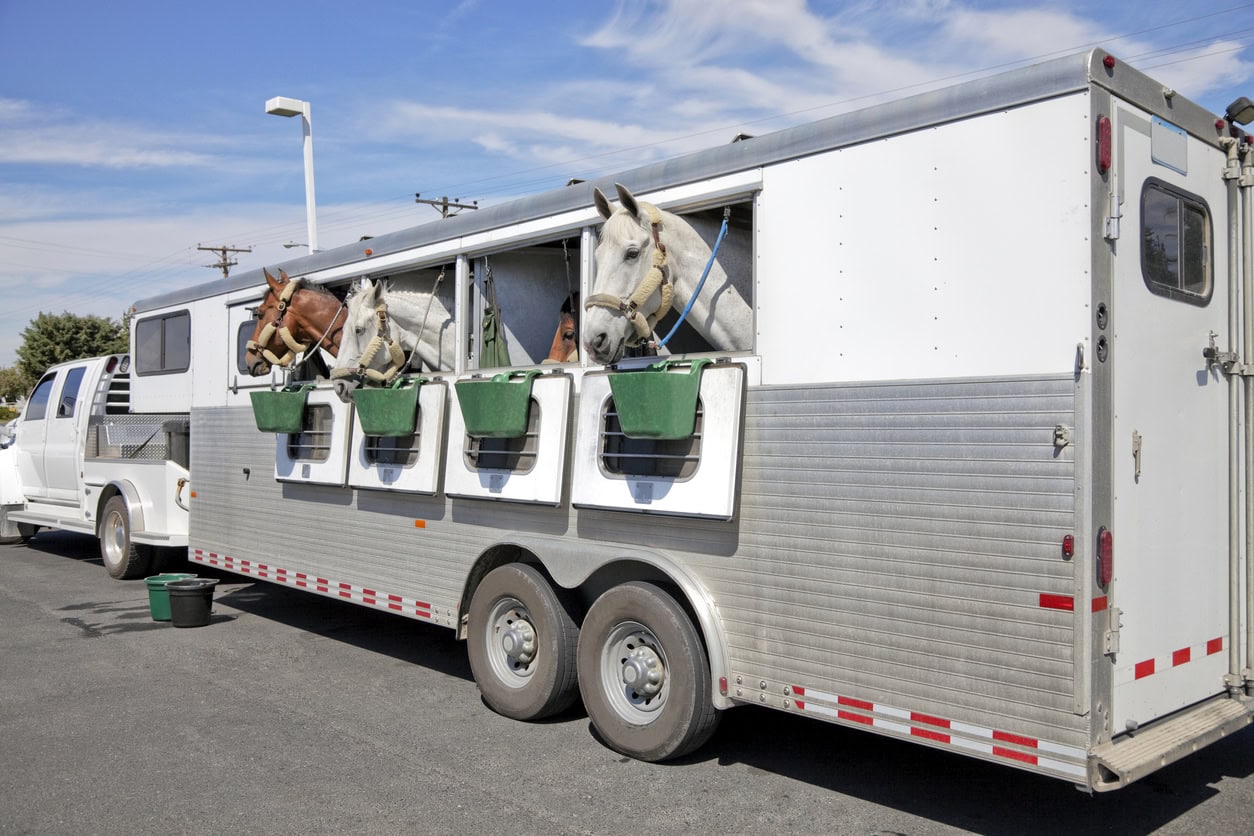What is the best way to support a horse affected by a ligament injury? Unfortunately, due to the nature of many equine disciplines, a horse’s ligaments are prone to injury.
In fact, ligament sprains (along with tendon injuries) are the most frequent cause of early retirement for Thoroughbred racehorses. [1]
Ligaments are a type of connective tissue made of strong, fibrous material that group together in bundles to form long cords. Ligaments connect adjacent bones in the horse’s body and have two main functions: keeping bones aligned and providing support for joints.
Eventing, racing, and other forms of competition all put significant strain on a horse’s tendons and ligaments, increasing the risk of injury. Degenerative changes that occur with ageing can also predispose a horse to a ligament injury. [2]
While some horses do make a full recovery and return to work, healing ligaments is more difficult than healing other tissues. The horse’s body can produce new connective tissue to repair ligaments, but rarely will they match the ligament’s original strength and function.
However, with some of the newer veterinary therapies available, horses may have a more hopeful prognosis. This article will review types of ligament injuries in horses and how to support recovery.
Ligaments of the Horse’s Legs
Horses have a number of different ligaments throughout their body, but the most commonly injured ligaments are located in the legs.
The following ligaments are most commonly affected by injury in sport horses:
Collateral ligaments stabilize a joint as it flexes and extends through its range of motion. The most commonly injured collateral ligaments in horses are located in the coffin, fetlock, and hock joints.
Palmar annular ligament of the fetlock, which starts from the sesamoid bones and stabilizes the flexor tendons, especially the superficial flexor tendon
Accessory (check) ligament of the deep flexor tendon, which runs from the carpus (knee) on the back of the leg and attaches to the deep digital flexor tendon about one-third of the way down on the cannon bone. This ligament helps with shock absorption and prevents excessive lengthening of the deep digital flexor tendon
Meniscal and cruciate ligaments on the upper hind legs. Both of these ligaments help to stabilize the horse’s largest joint: the stifle joint.
Suspensory ligament which supports the fetlock and protects it from hyperextension. This ligament is attached to the upper cannon bone in both the front and hind legs. It runs downward near the back of the cannon bone before dividing into two branches which attach to one of the sesamoid bones at the back of the fetlock.

Types of Ligament Injuries
Most ligament injuries occur in the horse’s forelegs since they bear 60% of the horse’s overall weight and are more likely to endure concussion.
The severity of a ligament injury can vary from a mild sprain to something more serious such as a tear or even a rupture. Depending on the type and severity of the injury, the treatment plan will vary as well.
The following are the classifications of ligament injuries:
Type I Lesions
Strains typically cause ligaments to stretch, resulting in swelling. The affected area usually becomes slightly enlarged, warm to the touch, and painful. Lameness may or may not be present.
Type II Lesions
Mild ligament tears are more serious than strains and usually result in increased swelling, heat, and often (but not always) lameness.
Type III and IV Lesions
Severe ligament tears are classified as Type III lesions while massive tearing is classified as a Type IV lesion. Type IV lesions result in severe lameness, obvious heat, pain, and swelling.
Injury Severity and Location
The more severe the ligament injury, the more lameness the horse will experience.
Of all the ligament injuries that can occur in a horse, inferior check ligament injuries are the least severe. Suspensory ligament injuries are the most common and also the most serious, as well as the most difficult to treat.
Suspensory ligament injuries may occur from a single traumatic event or they may be associated with chronic degeneration over time.
Because the suspensory ligament is so often affected in sport horses, injuries to this ligament are subdivided into three main categories depending on the location in which they occur:
- Suspensory injuries affecting the upper third, typically called proximal suspensory desmitis
- Injuries affecting the body of the suspensory ligament
- Injuries affecting the branches of the suspensory ligament
The suspensory ligament is also affected by the genetically inherited condition Degenerative Suspensory Ligament Desmitis (DSLD) which results in progressively worsening pain and lameness.

How are Ligament Injuries Diagnosed?
If you see lameness, swelling, or feel heat in any of your horse’s legs, the first step is to have him or her evaluated by your veterinarian.
A veterinarian will palpate the leg and can often tell which tendon or ligament is affected by injury. Palpitation is a useful diagnostic tool, but a confirmed diagnosis is usually made via ultrasound.
Ultrasound is the most useful tool for evaluating soft tissue injuries such as those of the ligaments. Veterinarians can evaluate these images to see which structure is damaged as well as the extent of the damage.
MRI and scintigraphy can also be used to diagnose soft tissue injuries, however, these techniques are sometimes less accessible.
Some ligament injuries are associated with little to no swelling and may go undiagnosed or misdiagnosed for a period of time. Lameness may be mild or sporadic, resolving after periods of rest and then later returning.
Horses may have bilateral lameness and a shortened stride instead of consistent lameness. They may also have poor performance with no visible cause.
In cases such as these, it can also be helpful to have your veterinarian perform a lameness examination. This will involve watching the horse move at a walk, trot, and canter, if possible.
It is beneficial to perform lameness exams on both hard and soft footing as some horses may be lamer on soft footing. Watching the horse move under saddle can also be helpful.
Treating Ligament Injuries in Horses
Treating ligament injuries often involves a multi-pronged approach. [13] It is important to keep in mind that these types of injuries take a considerable amount of time to heal.
Depending on the type and severity of the injury, many horses can return to soundness and live comfortable lives. [11]
Because of their unique structure and reduced blood supply, ligaments heal much more slowly than other parts of the body. Severe injuries can take up to a year to fully heal and these horses are often prone to re-injury. Senior horses may also heal more slowly than younger horses.
There are two main goals in supporting ligament injury repair:
- Increase blood flow to the area
- Encourage healing while also resting the injury
The following are treatments that can help horses recover from ligament injuries.
Stall Rest
In the acute (beginning) phase of a ligament injury, the goal is to reduce inflammation and limit the activity of proteolytic enzymes which break down protein. Restricted exercise is critical for healing to begin. [3]
The length of time to keep a horse on stall rest is subjective; it is usually determined by the individual horse, the owner, the environment, and the veterinarian. The recommended amount of stall rest may range from a few weeks up to several months.
After a period of stall rest and once the inflammation has subsided, owners should begin hand walking the horse, usually starting with 5-10 minutes twice daily. This amount is increased by 5 minutes each week up to 30 minutes twice daily. [3]
Repeat ultrasonographic examination should be performed 30-60 days after the injury and every 2-3 months afterward. Many horses with moderate injuries can begin tack walking after 30-60 days of hand walking. Trotting is typically introduced after 30-90 days of tack walking, depending on the severity of the injury. [3]
Ideally, deep bedding and small circles should be avoided during rehabilitation and race or jump training should not be resumed until at least 6-9 months after the initial injury.
Bandaging
Compression bandaging is often beneficial for ligament injuries. If done properly, bandaging can provide support and help to decrease inflammation. Poultices can also be applied beneath bandages to further decrease inflammation and speed healing time.
Bandages should be checked regularly and reapplied as needed.
Ice or Cold Water Therapy
Ice and/or cold water therapy are highly effective in reducing inflammation caused by ligament injuries, especially within the first 48-72 hours after the injury occurs. If using ice or cold water therapy in conjunction with bandaging, ensure that the leg is completely dry before re-wrapping.
Ideally, ice or cold water therapy should be maintained for 15-20 minutes two to four times daily. [3]
Pain Relieving Medications
Relieving a horse’s pain is a priority for many horse owners. Non-steroidal anti-inflammatory drugs (NSAIDs) can help to keep your horse comfortable if affected by a serious injury.
However, medications such as bute or banamine (as well as other NSAIDs) should not be used long term due to risk of gastric or colonic ulcers. Consult with your veterinarian about how to address pain while maintaining gut health.
Pain-relieving medications can also mask pain and encourage the horse to use the injured limb more than he or she should. This can slow the healing process or possibly result in re-injury of the ligament.
Laser Therapy
Laser therapy has become a popular treatment option for ligament injuries in recent years. This type of therapy is non-invasive, not painful and can easily be administered by veterinarians or specialized practitioners. [4]
The depth of tissue penetration will depend on the wavelength of the laser; high-intensity laser therapy (HILT) provides greater soft tissue penetration compared yto low-level laser therapy (LLLT). [5]
According to one study, HILT can lead to significant improvements in pain, swelling, and lameness associated with ligament injuries. [4][12]
Extracorporeal Shockwave Therapy
Extracorporeal shock wave therapy (ESWT) involves application of electromagnetic energy converted to high-energy shockwaves by an acoustic converter. This type of therapy may also be beneficial for ligament injuries.
Though little research exists on the effectiveness of ESWT, it is thought to increase blood flow, stimulate healing, and reduce pain.
One drawback with ESWT is that it can cause disorganization of collagen and micro-cracks in bone. Therefore, it is recommended to restrict exercise after treatment. [3]
Stem Cell Therapy
For many veterinarians, stem cell therapy is the gold standard of tendon and ligament repair. Stem cells are cells that have not yet been differentiated into a specific type of cell. They produce more than 30 types of growth factors and chemicals that stimulate healing.
When injected into the site of injury, stem cells can recruit other local stem cells in order to help repair damaged tissue.
With stem cell therapy, cells are extracted from a horse’s own fat tissue or bone marrow and implanted into the injured ligament under ultrasound guidance. This is purported to regenerate new, healthy tissue that resembles native tissue and restore the normal structure and function of injured tissues. [3]
The earlier stem cell treatment is started, the better the results will be. Researchers state that implanting stem cells within three weeks after injury is best. [6]
Platelet Rich Plasma Injection
Platelet Rich Plasma Injection (PRP) is another newer therapy used for ligament injuries. In this treatment, plasma with a platelet count greater than that of whole blood is injected into the site of injury.
This is believed to promote healing by enhancing cell migration and stimulating the development of new blood vessels. [3]
There is good evidence that both stem cell therapy and PRP can promote the growth of tissue that is stronger and more resistant to re-injury, especially in cases of tendonitis and ligament desmitis. [3]
Acupuncture
Though not well researched, the American Association of Equine Practitioners (AAEP) reports that acupuncture has been successfully used to treat many types of soft tissue injuries, including ligament injuries.
Acupuncture is based on the practices of Traditional Chinese Medicine and it has been used for hundreds of years for a variety of injuries and illnesses in horses.
When used for equine ligament injuries, acupuncture is reported to aid in pain control, reduce swelling, help with muscle spasms, and reduce the formation of scar tissue. It also promotes increased blood flow and regeneration of nerve cells.
Nutritional Support of Ligament Health
Nutrition plays a vital role in supporting ligament repair. Feeding your horse a diet balanced in vitamins and minerals can help to promote recovery and ligament health.
It is also important to keep your horse at a healthy weight. Horses that are over-conditioned experience greater strain on their joints, tendons and ligaments.
The following nutrients have all been found helpful in supporting ligament health in horses:
- Jiaogulan: a Chinese herb that promotes nitric oxide production which increases blood flow
- Glucosamine and Chondroitin Sulfate: these are often included together in joint health supplements, however it is unclear their effectiveness has not been clearly demonstrated in horses
- Hyaluronic acid: promotes collagen production by isolated cells but effects of supplementation in the horse are unclear. [7][8]
- Vitamin C: also known as ascorbic acid, this water-soluble vitamin is an important antioxidant that supports collagen production in bone and soft tissues [9]
- Amino acids: as building blocks of protein, amino acids are required for repairing tissues. In equine diets, the amino acids lysine, methionine and threonine are most likely to be rate-limiting for protein synthesis
- Methylsulfonyl methane (MSM): a readily available form of sulfur that is important for making proteins that are high in the amino acids methionine and cysteine
- Magnesium: the use of magnesium plated screws in bone/tendon repair surgery stimulated stem cell differentiation to bone. The utility of dietary magnesium for supporting ligament repair is unknown. [10]
- Omega-3 Fatty Acids: anti-inflammatory fatty acids, in particular DHA and EPA support joint health in horses and anti-inflammatory processes to lower inflammation
If you suspect your horse has suffered a ligament injury, consult with your veterinarian to identify the injury and for treatment and rehabilitation strategies.
It is also important to optimize their diet to ensure they have all the required nutrients for supporting ligament health tissue repair processes. Submit your horse’s diet online for free evaluation by our equine nutritionists.
References
- Clegg, P.D. Musculoskeletal disease and injury, now and in the future. Part 2: Tendon and ligament injuries. Equine Vet J. 2012.
- Dyson, S.J. Injuries of the accessory ligament of the deep digital flexor tendon in the equine hindlimb: a problem of middle-age. Vet J. 2010.
- Ortved, K.F. Regenerative Medicine and Rehabilitation for Tendinous and Ligamentous Injuries in Sport Horses. Vet Clin North Am Equine Pract. 2018.
- Zielinska, P. et al. Effects of High Intensity Laser Therapy in the Treatment of Tendon and Ligament Injuries in Performance Horses. Animals. 2010.
- Lacitignola, L. et al. Palmar annular ligament desmotomy in horses with the Arthrex-Centerline™ : An ex-vivo study. Open Vet J. 2018.
- Lange-Consiglio, A. et al. Investigating the efficacy of amnion-derived compared with bone marrow-derived mesenchymal stromal cells in equine tendon and ligament injuries. Cytotherapy. 2013.
- Osti, L. et al. Hyaluronic acid increases tendon derived cell viability and collagen type I expression in vitro: Comparative study of four different Hyaluronic acid preparations by molecular weight. BMC Musculoskel Dis. 2015.
- Foland, J.W. et al. Effect of sodium hyaluronate in collagenase-induced superficial digital flexor tendinitis in horses. Am J Vet Res. 1992.
- Oakes, B. et al. Vitamin C in orthopedic practices: Current concepts, novel ideas, and future perspectives. J Orthop Res. 2021.
- Wang, J. et al. Biodegradable Magnesium Screws Accelerate Fibrous Tissue Mineralization at the Tendon-Bone Insertion in Anterior Cruciate Ligament Reconstruction Model of Rabbit. Sci Rep. 2017.
- Lamb, L. et al. Clinical outcome of collateral ligament injuries of the tarsus. Can Vet J. 2012.
- Quiney, L. et al. Management of Primary Injuries of the Medial Collateral Ligament of the Carpus in Two Horses. J Equine Vet Sci. 2020.
- Wilson, J.M. et al. International Survey Regarding the Use of Rehabilitation Modalities in Horses. Front Vet Sci. 2018.












Leave A Comment